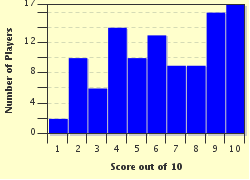Quiz Answer Key and Fun Facts
1. Who discovered the Rosetta Stone?
2. Which god presided over mummification?
3. Who was Hatshepsut?
4. The greatest number of Egyptian obelisks in the world is found where?
5. Abu Simbel is the site of which of these?
6. What is a sistrum?
7. Who deciphered the hieroglyphs?
8. What is a shaduf?
9. What is a cartouche?
10. What is an ostrakon?
Source: Author
russalka
This quiz was reviewed by FunTrivia editor
bloomsby before going online.
Any errors found in FunTrivia content are routinely corrected through our feedback system.

